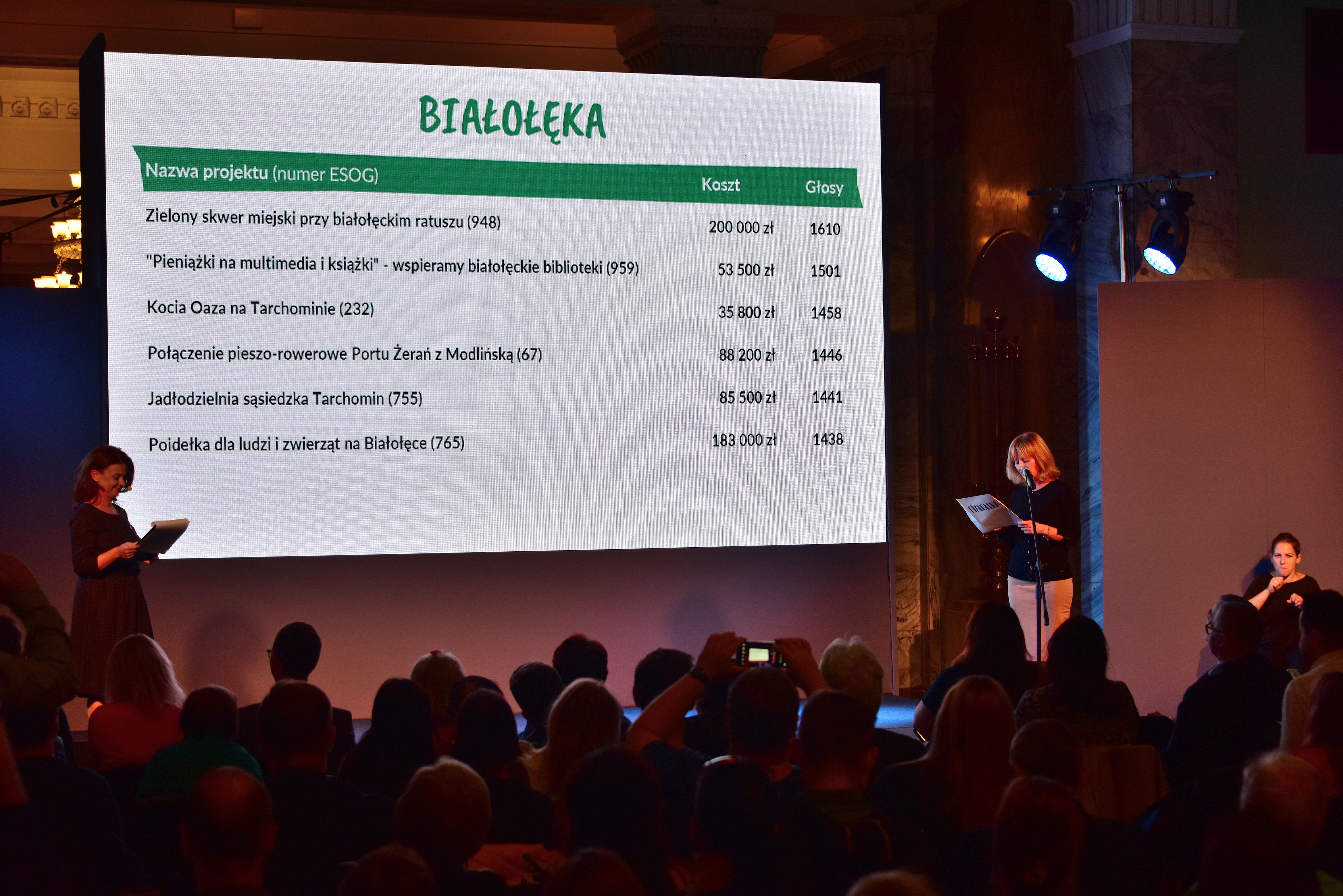|
Method Of Equal Shares
The Method of Equal Shares (in early papers the method has been also referred to as Rule X, but since 2022 the authors started using the name "method of equal shares") is a proportional method of counting ballots that applies to participatory budgeting to committee elections and to simultaneous public decisions. It can be used, when the voters vote via approval ballots, ranked ballots or cardinal ballots. If each voter has equal entitlement and each voter submits approval preferences, the Method of Equal Shares is a specific rule in a more general class of rules called PB-EAR that was designed earlier in 2019 by Aziz and Lee for ordinal preferences (that include approval ballots). Motivation The method is an alternative to the knapsack algorithm which is used by most cities even though it is a disproportional method. For example, if 51% of the population support 10 red projects and 49% support 10 blue projects, and the money suffices only for 10 projects, the knapsack budge ... [...More Info...] [...Related Items...] OR: [Wikipedia] [Google] [Baidu] |
Participatory Budgeting
Participatory budgeting (PB) is a type of citizen sourcing in which ordinary people decide how to allocate part of a municipal or public budget through a process of democratic deliberation and decision-making. Participatory budgeting allows citizens or residents of a locality to identify, discuss, and prioritize public spending projects, and gives them the power to make real decisions about how money is spent. Participatory budgeting processes are typically designed to involve those left out of traditional methods of public engagement, such as low-income residents, non-citizens, and youth. A comprehensive case study of eight municipalities in Brazil analyzing the successes and failures of participatory budgeting has suggested that it often results in more equitable public spending, greater government transparency and accountability, increased levels of public participation (especially by marginalized or poorer residents), and democratic and citizenship learning. Participat ... [...More Info...] [...Related Items...] OR: [Wikipedia] [Google] [Baidu] |
Justified Representation
Justified representation (JR) is a criterion for evaluating the fairness of electoral systems in multiwinner voting, particularly in multiwinner approval voting. It can be seen as an adaptation of the proportional representation criterion to approval voting. Definitions One definition for "proportional representation" is that the candidates are partitioned into disjoint parties, and each voter approves all candidates in a single party. For example, suppose we need to elect a committee of size 10. Suppose that exactly 50% of the voters approve all candidates in party A, exactly 30% approve all candidates in party B, and exactly 20% approve all candidates in party C. Then, proportional representation requires that the committee contains exactly 5 candidates from party A, exactly 3 candidates from party B, and exactly 2 candidates from party C. If the fractions are not exact, then some rounding method should be used, and this can be done by various apportionment methods. However ... [...More Info...] [...Related Items...] OR: [Wikipedia] [Google] [Baidu] |
Participatory Budgeting
Participatory budgeting (PB) is a type of citizen sourcing in which ordinary people decide how to allocate part of a municipal or public budget through a process of democratic deliberation and decision-making. Participatory budgeting allows citizens or residents of a locality to identify, discuss, and prioritize public spending projects, and gives them the power to make real decisions about how money is spent. Participatory budgeting processes are typically designed to involve those left out of traditional methods of public engagement, such as low-income residents, non-citizens, and youth. A comprehensive case study of eight municipalities in Brazil analyzing the successes and failures of participatory budgeting has suggested that it often results in more equitable public spending, greater government transparency and accountability, increased levels of public participation (especially by marginalized or poorer residents), and democratic and citizenship learning. Participat ... [...More Info...] [...Related Items...] OR: [Wikipedia] [Google] [Baidu] |
Proportional Representation Electoral Systems
Proportionality, proportion or proportional may refer to: Mathematics * Proportionality (mathematics), the property of two variables being in a multiplicative relation to a constant * Ratio, of one quantity to another, especially of a part compared to a whole ** Fraction (mathematics) * Aspect ratio or proportions * Proportional division, a kind of fair division * Percentage, a number or ratio expressed as a fraction of 100 Science and art * Proportional fonts * Proportionally fair, a scheduling algorithm * Proportional control, a type of linear feedback control system Other uses * Proportionality (law), a legal principle * Proportion (architecture), describes the relationships between elements of a design * Body proportions, in art, the study of relation of human body parts to each other and the whole See also * Proportional representation Proportional representation (PR) refers to a type of electoral system under which subgroups of an electorate are reflected proportiona ... [...More Info...] [...Related Items...] OR: [Wikipedia] [Google] [Baidu] |
Preferential Electoral Systems
In psychology, economics and philosophy, preference is a technical term usually used in relation to choosing between alternatives. For example, someone prefers A over B if they would rather choose A than B. Preferences are central to decision theory because of this relation to behavior. Some methods such as Ordinal Priority Approach use preference relation for decision-making. As connative states, they are closely related to desires. The difference between the two is that desires are directed at one object while preferences concern a comparison between two alternatives, of which one is preferred to the other. In insolvency, the term is used to determine which outstanding obligation the insolvent party has to settle first. Psychology In psychology, preferences refer to an individual's attitude towards a set of objects, typically reflected in an explicit decision-making process (Lichtenstein & Slovic, 2006). The term is also used to mean evaluative judgment in the sense of likin ... [...More Info...] [...Related Items...] OR: [Wikipedia] [Google] [Baidu] |
Vote Counting
Vote counting is the process of counting votes in an election. It can be done manually or by machines. In the United States, the compilation of election returns and validation of the outcome that forms the basis of the official results is called canvassing. Counts are simplest in elections where just one choice is on the ballot, and these are often counted manually. In elections where many choices are on the same ballot, counts are often done by computers to give quick results. Tallies done at distant locations must be carried or transmitted accurately to the central election office. Manual counts are usually accurate within one percent. Computers are at least that accurate, except when they have undiscovered bugs, broken sensors scanning the ballots, paper misfeeds, or hacks. Officials keep election computers off the internet to minimize hacking, but the manufacturers are on the internet. They and their annual updates are still subject to hacking, like any computers. Further ... [...More Info...] [...Related Items...] OR: [Wikipedia] [Google] [Baidu] |
D'Hondt Method
The D'Hondt method, also called the Jefferson method or the greatest divisors method, is a method for allocating seats in parliaments among federal states, or in party-list proportional representation systems. It belongs to the class of highest-averages methods. The method was first described in 1792 by future U.S. president Thomas Jefferson. It was re-invented independently in 1878 by Belgian mathematician Victor D'Hondt, which is the reason for its two different names. Motivation Proportional representation systems aim to allocate seats to parties approximately in proportion to the number of votes received. For example, if a party wins one-third of the votes then it should gain about one-third of the seats. In general, exact proportionality is not possible because these divisions produce fractional numbers of seats. As a result, several methods, of which the D'Hondt method is one, have been devised which ensure that the parties' seat allocations, which are of whole number ... [...More Info...] [...Related Items...] OR: [Wikipedia] [Google] [Baidu] |
Phragmen's Voting Rules
Phragmén's voting rules are multiwinner voting methods that guarantee proportional representation. They were published by Lars Edvard Phragmén in French and Swedish between 1893 and 1899, and translated to English by Svante Janson in 2016. There are two kinds of Phragmén rules: rules using approval ballots (that is, multiwinner approval voting), and rules using ranked ballots (that is, multiwinner ranked voting). Background In multiwinner approval voting, each voter can vote for one or more candidates, and the goal is to select a fixed number ''k'' of winners (where ''k'' may be, for example, the number of parliament members). The question is how to determine the set of winners? The simplest method is '' multiple non-transferable vote'', in which the ''k'' candidates with the largest number of approvals are elected. But this method tends to select ''k'' candidates of the largest party, leaving the smaller parties with no representation at all. In the 19th century, there was m ... [...More Info...] [...Related Items...] OR: [Wikipedia] [Google] [Baidu] |
Lindahl Tax
A Lindahl tax is a form of taxation conceived by Erik Lindahl in which individuals pay for public goods according to their marginal benefits. In other words, they pay according to the amount of satisfaction or utility they derive from the consumption of an additional unit of the public good. Lindahl taxation is designed to maximize efficiency for each individual and provide the optimal level of a public good. Lindahl taxes can be seen as an individual's share of the collective tax burden of an economy. The optimal level of a public good is that quantity at which the willingness to pay for one more unit of the good, taken in totality for all the individuals is equal to the marginal cost of supplying that good. Lindahl tax is the optimal quantity times the willingness to pay for one more unit of that good at this quantity. [...More Info...] [...Related Items...] OR: [Wikipedia] [Google] [Baidu] |
Pareto Efficiency
Pareto efficiency or Pareto optimality is a situation where no action or allocation is available that makes one individual better off without making another worse off. The concept is named after Vilfredo Pareto (1848–1923), Italian civil engineer and economist, who used the concept in his studies of economic efficiency and income distribution. The following three concepts are closely related: * Given an initial situation, a Pareto improvement is a new situation where some agents will gain, and no agents will lose. * A situation is called Pareto-dominated if there exists a possible Pareto improvement. * A situation is called Pareto-optimal or Pareto-efficient if no change could lead to improved satisfaction for some agent without some other agent losing or, equivalently, if there is no scope for further Pareto improvement. The Pareto front (also called Pareto frontier or Pareto set) is the set of all Pareto-efficient situations. Pareto originally used the word "optimal" fo ... [...More Info...] [...Related Items...] OR: [Wikipedia] [Google] [Baidu] |
Sequential Proportional Approval Voting
Sequential proportional approval voting (SPAV) or reweighted approval voting (RAV) is an electoral system that extends the concept of approval voting to a multiple winner election. It is a simplified version of proportional approval voting. Proposed by Danish statistician Thorvald N. Thiele in the early 1900s, it was used (with adaptations for party lists) in Sweden for a short period from 1909-1921, and was replaced by a cruder "party-list" style system as it was easier to calculate. Description Sequential Proportional Approval Voting (SPAV) uses Approval Voting ballots to elect multiple winners equitably by selecting a candidate in each round and then reweighing the approvals for the subsequent rounds. Each ballot is assigned a value equal to the reciprocal of one more than the number of candidates approved on that ballot who have been designated as elected. Each ballot is counted at its current value as a vote for all continuing candidates approved on that ballot. The candi ... [...More Info...] [...Related Items...] OR: [Wikipedia] [Google] [Baidu] |





